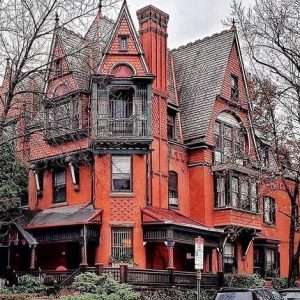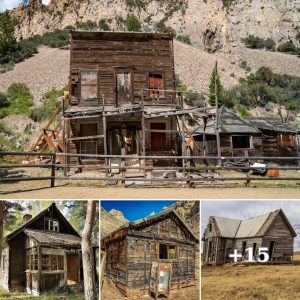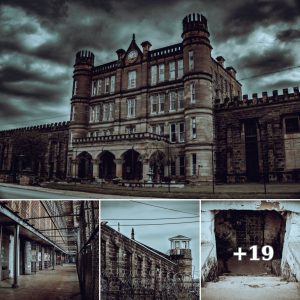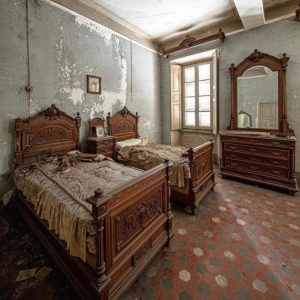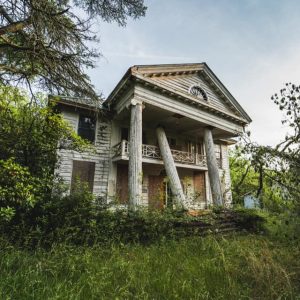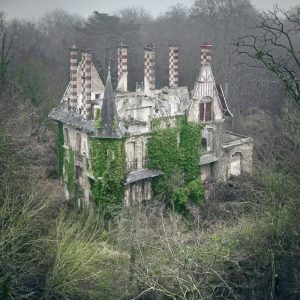
Elm Bluff Plantation | Dallas County, AL | c. 1845
The walls of these ruins contain the history of what was once the largest plantation in this section of Alabama, which spanned more than 5,000 acres and enslaved 200 people. Today, the land is maintained by a hunting group but what remains of the plantation house continues to deteriorate. With very few comprehensive accounts available on the history of this site, I set out to find as much as I could about the history of the region, the property, and the people who spent their lives here.
Early Territorial History
When European settlers first arrived in this region, they found vast pastures along winding rivers that had been inhabited by the people of the Choctaw and Creek Nations for generations. Following the Treaty of Fort Jackson in 1814, the natives were pushed out, and shortly after, white settlers began making their way into the area that would become the state of Alabama.
Some of the earliest to arrive here were fur traders and trappers who exchanged goods with the natives. But soon, more permanent settlers arrived, some from the north who came via ocean liners to Mobile, and then by steamship up the river system, while others came via land on wagon trains.
Cahaba: The River Capital
With few trails into the region, its river system became the lifeblood of settlement and farming in this new territory. So when Alabama became a state in 1819, its first capital, Cahaba/Cahawba, was carved out of the wilderness where the Alabama and Cahaba Rivers met. The town was drawn up to mimic the street plans of northern towns that many of its earliest residents favored.
Some of the most prominent of these early settlers were the Crocherons and LaTourettes, families from Staten Island, NY of French Huguenot descent. They had great success in New York as traders and merchants and in the early 1820s, migrated en masse to the new state of Alabama via ship to Mobile.
They built mansions, invested in land, established a bank, conducted business in the steamship industry, and opened stores in the new state capital. But prosperity in Cahaba was short-lived due to frequent floods and fevers that devastated residents. So in 1826, the capital was relocated to Tuscaloosa, and Cahaba was left behind.
A New Port Emerges
Not to be deterred from their investments in the area, John Jay Crocheron, a bachelor born in Staten Island, NY, set his sights on establishing a new river port in a more ideal location than Cahaba had been. His experience with steamships and time in Cahaba had offered him insight into the struggles of the steamships as they navigated the muddy rivers. So he made a plan and scouted out a bend in the river about 20 miles south of the former capital where he thought a boat landing would be ideal.
He sold his interests in the bank and his others businesses and began buying up as many land patents downriver as he was able. Between 1830 and 1850, John purchased hundreds of land patents that eventually amounted to 5,000+ acres of land [1]. The area had been called Centre Ridge but soon became known as Centre Port once it had been established as a steamboat landing and between 1840 and 1850, became one of the most important landings on the Alabama River.

John Jay Crocheron, who never married, would have been one of the very few white settlers who lived in this section at that time. But that would soon change as he encouraged more of his relatives and contacts to relocate from New York. In the following years, more of the planter class began to arrive from the Carolinas and Virginia, many bringing enslaved people with them.
By the 1860s, the community of Centre Ridge had gone from pioneer society to planter society with more than 60% of the population being enslaved persons. By then, this section had a tannery, several cotton gins, 4 grist mills, a wagon maker, and 2 churches, one of which, Centre Ridge Presbyterian, was built on 2 acres donated by John Jay Crocheron in 1842.

Elm Bluff Plantation
Without question, at more than 5,000 acres, John Jay Crocheron’s was the largest of the plantations in this section. At the center of his land were the boat landing, dock, warehouses, and elevators that serviced the steamships on the Alabama River. It was here, situated on the highest bluff, that John chose the site for his plantation home that he named Elm Bluff.

Regarded by many architectural scholars as ‘A New York House In A Deep South Setting,’ the Greek Revival style house is 2.5 stories. The house has the unique feature of frieze ‘eyebrow windows’ on the top floor using a Greek Key motif. These unusual windows, similar to those in the Staten Island home where John grew up, allowed light and air circulation into the largely hidden 2.5/3rd floor. The interior is divided by a central hall on all floors with two rooms on each side and a series of wide staircases that wind up to the top floor. Many of the home’s features are thought to have followed the pattern books of Asher Benjamin and Minard Lefever [2].

The exterior of the mansion features a covered portico on the front and also once had a two-story brick extension off of the rear for the kitchen that was wrapped by a porch. The building, which is thought to have been built between the years of 1840-and 1845, is made completely of brick that was shipped in from England and used as ballast on the boat and granite that was shipped in from the North.

A Riverboat Hotel
Travel back then was most commonly by the river and as often was the case, the steamships would get stuck in the mud banks of the Alabama River, causing delays of 2-3 days in some cases. So John first set up a camp house for travelers and then, when the big house was complete, would open it up to distinguished locals who needed a place to stay while waiting for ships to arrive. As such it was often referred to as the Elm Bluff Hotel and featured an extensive library from which guests could read, including periodicals from America and Europe. But back in those days, a bachelor like John Crocheron couldn’t entertain guests on his own so he had a ‘Lady Housekeeper’ who came down from New York to serve as hostess at the home [3].

Enslaved History at Elm Bluff Plantation
As John Jay Crocheron continued to amass great property and wealth in Alabama, he also purchased hundreds of people who he enslaved on this plantation. According to family accounts [4] and census records [5], he held no less than 200 people in bondage here who operated his massive plantation and riverboat landing. By 1860, the work of the enslaved people and business conducted on this plantation brought John Jay Crocheron’s wealth to a staggering $125,000 [6], which would be more than $4 million today.
I was able to piece together a few details about one enslaved family here that began with a man named Caliph (perhaps spelled Caleb) who was born in South Carolina around 1799. Between 1819 and 1840, he and his wife Mary, who had been born in Virginia in 1805, gave birth to at least 7 children at Elm Bluff who would grow up enslaved here. One of their child, born in 1838, named Oliver Crocheron, would marry a woman named Mahlia Cupe, who had grown up enslaved here as well. Their son, Caleb Crocheron, was born free on the same plantation in 1867 or 1869 [7].
And while there are countless stories we will never know about the others who spent their lives here, I was able to find a document from the church that listed on its roster the enslaved church members, followed by the names of their ‘masters.’ [8] Listed here are the names of people enslaved by John Jay Crocheron from the roll of Centre Ridge Episcopal Church members, 1842-1861:
- Abe
- Agnes
- Ann
- Bill
- Bob
- Easter
- Edy
- Fanny
- George
- Hal
- Hannah
- Hannah
- Henry
- Jack
- Jane
- Jinnie
- Jonas
- Julia
- Lewis
- Lockwood
- Lucinda
- Maria
- Martha
- Martin
- Mary
- Mary Ann
- Mary Frances
- Matilda
- Patric
- Polly
- Prince
- Sally
- Sam
- Sam
- Sarah
- Sophia
- Stephen
- Tamar
- Toby
- Toby
- Toby
- William
- William Henry
Civil War At The Plantation
As war broke out between the North and South, members of Alabama’s planter class were well-situated on the side of the Confederacy. But when Alabama seceded from the Union in 1861, some of the planter class returned North, including members of the Crocheron Family, while most men were sent off to fight. But John Jay Crocheron, being a bachelor in his mid-60s by now, decided to stay at his plantation in Alabama and found a way to support the war efforts from Elm Bluff. He financed a cavalry troop [9] and at the beginning of the war, presented them with 100 Colt Dragoon Revolvers. In his honor, they were named Crocheron’s Light Dragoons (sometimes noted as “C.L.’s Dragoons” or “CLD”) who would go on to serve as escort company to commanders in the Army of Tennessee where they would see battle at Chickamauga, Chattanooga, and Shiloh.
But John would not see the end of the war because, in September 1864, he fell ill, and on October 17, 1864, passed away at Elm Bluff Plantation. His body was buried nearby at Centre Ridge Episcopal Church Cemetery on the land he had donated.
Because he had no children of his own, he appointed his nephew, David S. Latourette, and his niece, Joanna H. Evans, as executors and heirs of his entire estate. In 1865, David passed away, leaving Joanna as the sole heir [10].
After The War
As you might expect, times were difficult for everyone after the war came to a close. The plantation economy collapsed but many of the people who had been recently freed stayed on the land they knew and continued to work as sharecroppers. According to the 1870 Census, the following freed people were living at Elm Bluff [11]. As was common during this time, these people would adopt the surname of the former plantation owner:
- Brince (Prince) Crocheron
- Agness Crocheron
- Beryl Crocheron
- Harry Crocheron
- Lewis Crocheron
- Hannah Crocheron
- James Crocheron
- Dick Crocheron
- Dinah Crocheron
- Jennie Crocheron
- Emily Crocheron
- Dick Crocheron
- Peter Crocheron
- Willis Crocheron
- Abram Crocheron
- Eliza Crocheron
- Henry Crocheron
- Fanny Crocheron
- Tamar Crocheron
- George Crocheron
- Benjamin Crocheron
- Jane Crocheron
Throughout the late 1800s, the big house operated as a hotel for riverboats until river travel was surpassed by the rails that came through the area.

1900-Today
Over the following decades, many moved away, looking for better work and opportunities in bigger cities. The property passed hands through distant descendants of John Jay through the 1930s when the last of them died with no heirs. The property was sold off for hunting land and has been leased for that purpose ever since to hunters. Coincidentally, today these outdoorsmen have come to call their hunting camp ‘The Hotel’ again.
In more recent years, the structure, which never had electricity or indoor plumbing, has fallen victim to vandalism and damage from weather and animals. All of the interior features have been stolen from the building, including the stair railings, windows, doors, mantels, and interior woodwork that lined the walls. Vultures have made their home on the top floor and the overgrowth swallows the structure throughout the warmer months. In the early 2000s, an effort was made to try and save the building, but it never came to be.
The property is privately owned and not open to the public.

The photos included below are courtesy of Altairisfar via creative commons license.





Citations
- [1] Bureau of Land Management, “Land Patent Search,” digital images, General Land Office Records. John Jay Crocheron 1830-1845; Dallas County, AL.
- [2] Cooper, Chip; Knopke, Harry; Gamble, Robert (1993). Silent in the Land. Tuscaloosa: CKM Press.
- [3] Gildersleeve, Virginia Crocheron (1954). Many a Good Crusade: Memoirs of Virginia Crocheron Gildersleeve. New York: Macmillan. pp. 3–5.
- [4] Gildersleeve, Virginia Crocheron (1954). Many a Good Crusade: Memoirs of Virginia Crocheron Gildersleeve. New York: Macmillan. pp. 3–5.
- [5] U.S. Census Bureau; 1840 Census, 1850 Slave Schedule, 1860 Slave Schedule.
- [6] J.J. Crocheron Wealth Estimate from U.S., Selected Federal Census Non-Population Schedules, 1850-1860.
- [7] Story of Caliph (Caleb) Crocheron and his family from Ancestry.com.
- [8] Centre Ridge Church Roster- Slaves (And Owners)- Transcribed from The History of Centre-Ridge Presbyterian Church, Dallas County, Alabama Minute Book, 1842-1911. Transcription copyright of Kathy Leverett, 2013, All Rights Reserved.
- [9] History on Colt’s Light Dragoon’s Cavalry from Old South Antiques.
- [10] Transcribed from the will of John J. Crocheron; written September 1864, confirmed December 1864 in Dallas County, Alabama Probate Court. Transcription done by Kelly Gomez, 2022, All Rights Reserved.
- [11] U.S. Census Bureau; 1870 Census.
Acknowledgements
Much of the information about the Community of Centre Ridge was drawn from an extensive paper, completed by William Palmer Moulder, A History of Centre Ridge Dallas County, Alabama, University of Alabama Thesis, 1936.
